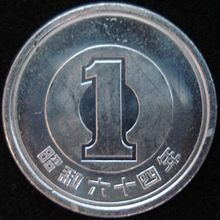Japan | |
| Value | 1 Japanese yen |
|---|---|
| Mass | 1 g |
| Diameter | 20 mm |
| Edge | Smooth |
| Composition | 100% Al (current) |
| Years of minting | 1871–present |
| Obverse | |
 | |
| Design | Young tree with the words "State of Japan" above, and "1 Yen" below |
| Design date | 1955 |
| Reverse | |
 | |
| Design | "1" in a circle with year of issue in kanji Showa era year 64 (1989) |
| Design date | 1955 |
The 1-yen coin (一円硬貨, Ichi-en kōka) is the smallest denomination of the Japanese yen currency. Historically they were initially made of both silver and gold in the early 1870s. Issues facing the Japanese government at the time included wanting to adopt the gold standard, and competing against the Mexican dollar for use in foreign trade. The decision was made to use silver one yen coins exclusively outside of Japan for trade, while gold coins were minted and used in mainland Japan. Gold and silver coins were eventually allowed to co-circulate in mainland Japan from 1878 to 1897 when they were demonetized. Millions of former one yen silver coins were countermarked by the Japanese government for use outside of the mainland. Silver one yen coins continued to be minted until 1914 for backing up currency.
One yen coins were not made again until after World War II in the late 1940s for a brief period of time. The current one yen coin design was first minted in 1955, is made up of pure aluminium, and has a young tree design which has been used since. Between 2011 and 2013 and since 2016, production of the coin was confined to mint sets due to lack of demand caused by increased usage of electronic money. Like with the U.S. penny, the Japan Mint has minted one-yen coins at a loss due to the rising cost of the base metal used in the coins.